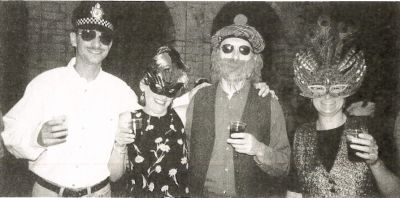Erice 97
At the Direct Methods Of Solving Macromolecular Structure Meeting, (May 1997, Erice) eighteen invited speakers lectured and led an intense programme of tutorials for 76 "students" from 23 countries.
Participants were provided with a comprehensive and in-depth overview of crystallographic structure determination methods for macromolecules. Direct and experimental phasing techniques were presented, highlighting their complementarities and synergies. Methodologies spanning the full crystallographic image reconstruction process - from low resolution envelope definition to high resolution atomic refinement- were discussed.
The first part of the Institute described the mathematical, computational or experimental tools currently used in structure determination and illustrated the variety and ingenuity of approaches developed to solve increasingly complex structures. Many recent developments and implementations have given older approaches a new life. A case in point is the re-implementation of Buerger's superposition approach, which is now solving protein structures. Another beautiful example concerned the traditional multiple isomorphous replacement approach where new techniques, such as site-directed mutagenesis and the use of inert gases in the preparation of heavy atom derivatives, were described. Equally impressive were the presentations of newer approaches, which take advantage of advances on the experimental front (e.g., MAD and solvent contrast variation) the mathematical front (e.g., minimal function and maximum entropy) and the computational front (e.g., simulated annealing and density modification).
The second part of the meeting focused on applications. MAD is solving larger and larger structures. With a growing protein databank and more efficient techniques, the power of molecular replacement continues to increase its presence. The use of phase information from electron microscopy images within the ME approach can attack such complex structures as membrane proteins. Shake-and-bake and the SHELX "half-baked" approaches continue to dazzle us with their successes, the culmination of which was the structure determination of a 1,001 atom protein structure on site by SHELX! Increasingly large structures, such as ribosomal particles and virus structures, are being investigated using tailor-made methods.
The Institute concluded with a series of presentations on the newest phasing methodologies and offered the promise of yet more achievements to come. Two main ideas emerged from the Institute. First, the time has passed for looking at different approaches as "competing". Much can be gained by combining the various techniques, exploiting their complementarities and synergies. Second, direct methods have often set their sights high, sometimes against the prevailing opinions of the day. This has provided us with the inspiration and motivation needed to continually re-energize and re-vitalize our field. It has also resulted in unexpected achievements, such as the ab initio structure determination of lysozyme achieved in Erice during the Institute.
Beyond the NATO ASI award, sponsors were the IUCr, the European Commission, DG XII, Office for Central and Western Europe, and Merck and Co., Rahway, USA.
Suzanne Fortier, ASI Director The occasion of the 25th Erice School on Crystallography caused P. Spadon and L. Riva di Sanseverino to outdo themselves in adding events to what is arguably a premier crystallographic meeting. Most memorable was the Ball Masque. Would you trust these people to solve your problems?
The occasion of the 25th Erice School on Crystallography caused P. Spadon and L. Riva di Sanseverino to outdo themselves in adding events to what is arguably a premier crystallographic meeting. Most memorable was the Ball Masque. Would you trust these people to solve your problems?
An Advanced Study Institute in Electron Crystallography motivated by the rapid growth of the use of this powerful technique for studying microcrystalline materials was conducted in polluted water on the ASI on Direct Methods for Solving Macromolecular Structures, organized by S. Fortier. The presence of concurrent courses on related subjects enhanced both schools since experts on phase determination could address the electron microscopists and, the microscopists could persuade traditional X-ray crystallographers that there were other ways to derive useful structures. Cross-references to each other's techniques and points of view were made throughout both courses. In course evaluation, 48 students stated that concurrent meetings have a very positive impact. Students also praised the lab sessions where they gained 'hands-on' experience. It was necessary, moreover, to exploit a variety of computer platforms (e.g. Windows-based PC's, UNIX-based workstations) in order to present these concepts in a practical way. A senior member of the direct methods school visited an electron crystallography practical and commented that the feeling 'was just like the days when direct methods were new and exciting'. B. K. Vainshtein, who was to be one of the lecturers of the course. died unexpectedly in late 1996. His anticipated contribution was given by two of his colleagues: V. Klechkovskaya and B.B. Zvyagin. The published proceeding of the school will be dedicated to Vainshtein's memory and a special award in Vainshtein's memory was given to Zvyagin. Sponsorship for the ASI was obtained from NATO, Euroconf.,DG XII Office for Eastern European Countries, the IUCr, Italian Res. Council Comm. for Minerology, US Natl Science Foundation and Astra-Sweden.
Douglas Dorset

![[Crystallography Around The World] [Worldlogo]](https://www.iucr.org/__data/assets/image/0005/149540/world_bw.png)